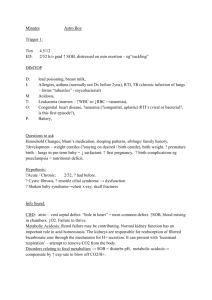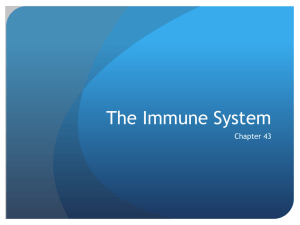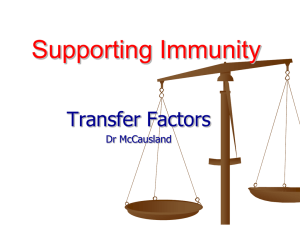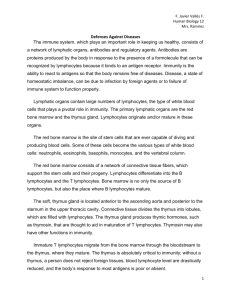Minutes Astro Boy Trigger 1: Tim 4.5/12 ED: 2/52 h/o grad ↑ SOB on
advertisement
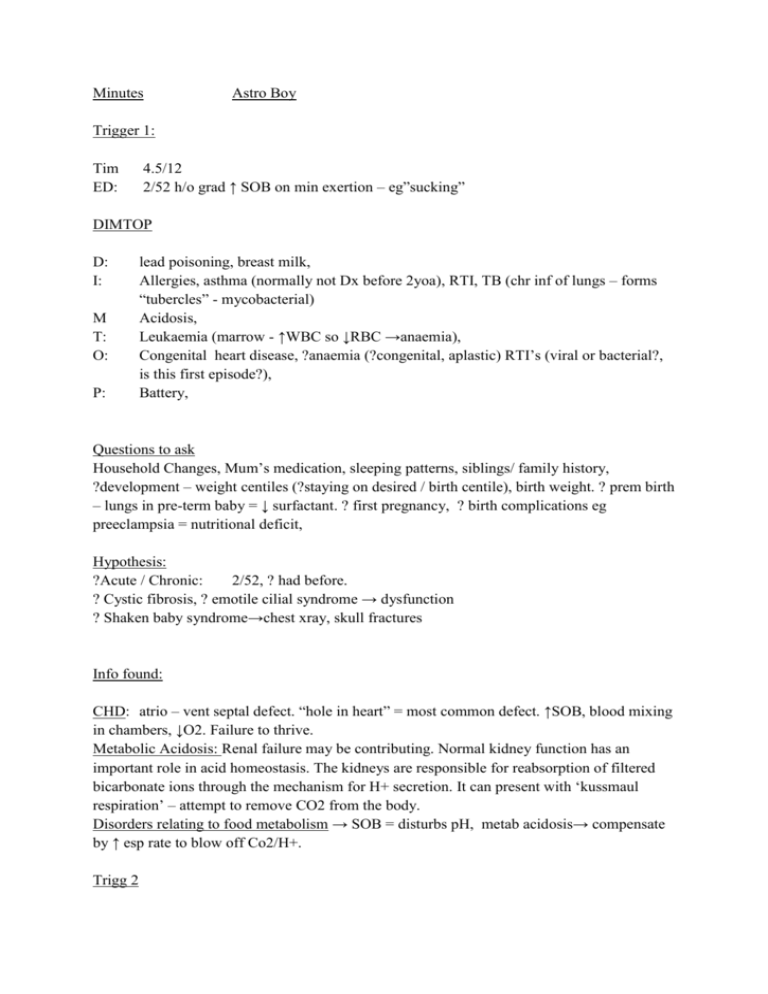
Minutes Astro Boy Trigger 1: Tim ED: 4.5/12 2/52 h/o grad ↑ SOB on min exertion – eg”sucking” DIMTOP D: I: M T: O: P: lead poisoning, breast milk, Allergies, asthma (normally not Dx before 2yoa), RTI, TB (chr inf of lungs – forms “tubercles” - mycobacterial) Acidosis, Leukaemia (marrow - ↑WBC so ↓RBC →anaemia), Congenital heart disease, ?anaemia (?congenital, aplastic) RTI’s (viral or bacterial?, is this first episode?), Battery, Questions to ask Household Changes, Mum’s medication, sleeping patterns, siblings/ family history, ?development – weight centiles (?staying on desired / birth centile), birth weight. ? prem birth – lungs in pre-term baby = ↓ surfactant. ? first pregnancy, ? birth complications eg preeclampsia = nutritional deficit, Hypothesis: ?Acute / Chronic: 2/52, ? had before. ? Cystic fibrosis, ? emotile cilial syndrome → dysfunction ? Shaken baby syndrome→chest xray, skull fractures Info found: CHD: atrio – vent septal defect. “hole in heart” = most common defect. ↑SOB, blood mixing in chambers, ↓O2. Failure to thrive. Metabolic Acidosis: Renal failure may be contributing. Normal kidney function has an important role in acid homeostasis. The kidneys are responsible for reabsorption of filtered bicarbonate ions through the mechanism for H+ secretion. It can present with ‘kussmaul respiration’ – attempt to remove CO2 from the body. Disorders relating to food metabolism → SOB = disturbs pH, metab acidosis→ compensate by ↑ esp rate to blow off Co2/H+. Trigg 2 Ti youngest of 3 (not refugee or from “exposed” country) 10 y/o sister 8 y/o brother Dad commercial lawyer, Mum p/t accountant. (parent literacy) Birth normal 3.5kg, APGAR score = 10 Despite initially well, nasal discharge since birth. Poor WG despite good appetite for breast milk 10/52 = URTI → bronchitis, responded to Ab. Otitis media ( middle ear inf) shortly after → again responded well to Ab. Ear inf 2/52 later, again Ab successful. 6/52→ 20+ times per day diaorrhea 5 hosp admissions since born. Most recent 3/52 ago treated with IV fluids. APGAR: Colour Breathing HR M tone Response to touch Questions to ask ? immune system compromised / effected Leukaemia Acidosis kidneys Acquired Immune deficiency Anaemia congenital Resp Inf – in immune compromised Found Out: Hannah is a Rabbit Leukaemia: asscoc with diaorrhea. 2 types Lymph/myo blastic cells. Age 2-5 most common = Acute Lymphoblastic Leuk Fever - (inf) WL, bruising (↓platelet count) Acidosis kidneys: Can involve diabetes, poisons, kidney disease. Can get diaorrhea as a result. Resp distress = comp mechanism. May exp why Tim had IV fluids. Does not correlate with no. of infections Tim has had (4-8 in first year of life OK) Acquired Immune deficiency: Dev due to non genetic abnormalities. Acquired during life. HIV (Human Immuno-deficiency Virus) = most common. Affects T-Lymphocytes – innate immunity. Drops count of T-lymphocytes. Other factors = nutritional (albumin paucity due to ↓ protein effects synthesis), medical treatments, infections. Anaemia congenital: Caused by congen defects leading to cell production and maturation defect. Many types of deficiency Common factor = inf comp↑susceptability to inf manifested after birth. Respiratory Inf – in immune-compromised: Often present with recurrent symptoms. Eg epsteint barr virus→ damage leads to compromised defence system in patient. Considered” likely” in Tim’s case. Middle cear com site – it is more the freq that concerns us Types of Immunity. Work differently: Cell Mediated Immunity T- Lymphocytes – manifests first few months of life. Humoral Immunity M– more of an issue in last half of first of year as still getting mum’s immunity before then. (Think timing of “booster” shots) Adaptive Immunity: Specific lymphocytes: B cells → humoral (marrow), T Cells (Thymus)→cell mediated. Heve “memory” for subseq inf. Innate: (Non-specific) neutrophils/ macrophages Trigger 3 Examination: Obs: Irritable / cyanosed infant. (lips, tongue) RR 40/min BP 85/55 HR 160/min T 37.8 W 3.6kg (< ist cent), muscle wasting noted White plaques on tongeue Buccal mucosa Mucopurulent d/charge from nose No visible tonsillar tissue Ausc: audible wheeze, with widespread crackles over liung fies. I/C recession and trach tug. Ear: Tymp Memb (separates middle from inner ear – t’mits sound) bilat inflamed Abdo: Exam difficult - passed 50mls faeces during No signs chronic liver disease. Genital rash extending to anus. Excoriated, raised, red I/C admission Samples taken for inv:→ blood, faeces, urine, mouth swab, chest x-Ray, (mucus→gastric washings in kids). Need to know: Resp: Nasal Discharge. Mucopurulent = mucus AND pus Resp: Auscultation Crackles –(explosive sounds in airway. Fluid related“ like crumpling up chip packet”. Trach tug downward movement of hr cart. Aortic aneurism, COPD, Intercostal Recession→ negative intrathoracic pressure causing indrawing Vitals: RR 40 (30 -45) HR 160 (90-120) T 37.8 (36.5-37.5) Wt 3.6kg 1st cent < (7kg) BP 85/55 Abdo / GIT Genital Rash: “nappy rash” skin exp to wet dirty nappies. Thrush or other fungal infection can also cause. Often worse in immune-compromised babies. Birth weight / Development: Muscle Wasting: Secondary to failure to thrive Yellow Stool: Sign of GIT infection (can be white also) Pallatine tonsil: First line of pathogen defence. Lymphoid tissue. Can be eroded by acid reflux. Found Out: Resp: Nasal Discharge Resp: Auscultation: wheeze and crackles due to mucus buid-up Abdo / GIT Genital Rash Birth weight / Development: Muscle Wasting: Buccal mucosa Session 2: Summary of above presented. So: multiple organ involvement. Widespread infection. WHY? Probably an immunity problem Trigger 4 Investigations: Radiology: Bilateral diffuse opacities in both lung fields in an interstitial pattern. The Radiologist commented that the pattern of interstitial pneumonitis was consistent with Pneumocystitis carinii. No Thymic shadow seen on film Faecal exam: no parasite seen latex agglutination for Rotavirus - positive → ? causing diarrhoea Oral, Groin scrapings: Candida albicans Neutrophil Respiratory Burst Test: 95% (N=> 90) Electron Microscopy of cilia = normal Nasopharyngeal aspirate - Gram neg bacilli on gram stain, culture grew pseudomonas aeruginosa. DNA test for cystic fibrosis: negative HIV antibody: negative. Serum biochemistry and blood gases: were consistent with severe dehydration and respiratory failure requiring mechanical ventilation Found Out: Pseudomonas aeruginosa: gram neg bacilli. Bacterial commensal. Commensal = usually normal flora, but can be infective if immune system deficient. Aerobic. Lungs. Few nutritional requirements. Significance: presence in lower resp tract = indicative of immune deficiency. Nutritional Burst Test oxidative burst, O2 dep method of killing bacteria. Less chem in cell very active. Tests for partic aspect of immune system. Tests for ability of body to be able to kill and phagocytose bacteria. Seems to be intact given normal radings. If was low, may indicate secondary problem PCP Fungus. Common in environment / air. Not normally in lung. Presence = immune deficiency Should appear as relatively large in infants / children. If not visible will affect immunity→ T cell compromise (mature in Thymus), ↓ adaptive response capacity. Thymic shadow Trigger: 5 Investigations (cont) Haeamatology: Hb 80.0 (100-140g/l) Low WCC 4.8 (4.0-11.0) x109 Lower end of Normal Lymphocytes 0.76 (2.2-7.0)* x109 Low *may vary from one lab to another but note that is higher than in adults (this comment from “Gordo’s Notes”) Immunoglobulins: IgG 1.7 (1.7-8.1) g/l Low end of Normal IgA <0.01 (0.04-0.84) g/l Very Low IgM <0.01 (0.27-1.0) g/l Very Low (age adjusted reference ranges allow for lowest to highest concentrations from 4-5 months of age) Lymphocyte subsets CD3 <0.01 (1.7-3.6) x 109 (all T Cells) Very Low 9 CD4 <0.01 (1.7-2.8) x 10 (helper-induced cells) Very Low CD8 <0.01 (0.8-1.2) x 109 (cytotoxic suppressor cells) Very Low CD19 0.75 (0.5-1.5) x 109 (all B Cells) Normal 9 CD16 0.07 (0.3-0.7) x 10 (Natural killer cells) Very Low Complement concentration and activity C3 1.6 (0.9-1.8) g/l Normal C4 0.31 (0.16-0.50) g/l Normal CH50 578 (520-660) U/ml RI is method dependant Summary Low Hb Lacks Thymus: Therefore unable to make functional T cells (maturation dysfunction). T cell abnormalities in keeping with thymal deficit. Immature CD4 and CD8 cells are matured in the Thymus → CD4+ and CD8+. T Cells: In thymus→pos and negative selection. Dendritic interaction All nucleated cells have potential to present MHC on membrane which can be potentially targeted by T cells → apoptosis. See Link: http://www.youtube.com/watch?v=odLLr6mjaUQ Cytokines are necessary Tim’s B cells are normal but because fo the lack of Helper T cells, they are unable to undergo clonal expansion despite his infections → low immunoglobulin Lack of T Helper cells also means the NK cells (part of INNATE ) immunity are not activated either despite his frequent infections IgG Borderline (may have maternal IgG) IgA, IgM both low: Tim’s dysfunction Lack of latter two = B Cell dysfunction. Immunoglobulins not being produced adequately. Relevance: B cell numbers Ok, but not functioning well. Lymphocytes: Low numbers = adaptive response compromised Compliment concentration and activity: Involved in innate and adaptive component. Normal readings → intact So: Not HIV positive Trigger 6 Tim’s results were consistent with Severe Combined Immunodeficiency Disease (SCID) Tim required mechanical ventilation and treatment with multiple intravenous antibiotics and a tropical antifungal. Intravenous feeding was instituted in an effort to improve his nutrition. He was transfused with a unit of fresh, irradiated cross-matched CMV-negative whole blood followed by subcutaneous immunoglobulin daily for four days. He made slow but steady progress on this regimen and came off the ventilator after seven days. Siblings and parents were HLA typed So: Given irradiated blood: Don’t want T and B cell from donor blood attacking the host. Gamma rays are used to destroy lymphocytes. Limit graft v host response. In normal – host lymphocytes would normally kill donor lymphocytes Bone Marrow Transplant – beware graft v host response IV feeding: Malabsorption through GIT. If IGa deficient will also negatively impact in GIT HLA important for transplants. Irradiate to eliminate pathogens Cross matching to limit chance of blood attacking self Limit chance of reactions given limited defence. SCID: Causes: genetic syndrome ↓ T cells, failure to thrive, chronic diarrhoea 50% = x-linked. Autosomal recessive = remainder ( ¼ affected, 2 in 4 = carriers) See Link for SCID http://www.scid.net/ See Link below for X-Linked explanation http://ghr.nlm.nih.gov/condition/x-linked-severe-combined-immunodeficiency Trigger:7 Tim continued to respond well to treatment Bone marrow transplant at one month following admission once well enough to undergo operation.His 10y/o sister was found to have the closest match in HLA antigens. Mum expressed concern re donations, offered to make donations herself. So: Mother can only have 50% match Siblings more likely to have a better match? Obvious issues of donations by minors – see relevant learning objective.(14.10) Rejection an issue. Graft v Host response. Why particularly significant with immune deficiency. On anti rejection drugs long term Last trigger: Closure: 3/52 post transplant, definite evidence of engraftment based on the rising lymphocyte count. 3/12 post transplant, there was complete engraftment so that all immunology tests returned to normal. 10th centile for height and weight. (prev 1st) So: Which parts of immune system addressed by transplan? Every blood cell type would have potential to be addressed. Reconstituting immunity system via “production-line” effect. Transfused Ig products by contrast have a “shelf life”. Note: Thymus part of reticuloendotheleial system.
